初中英语语法时态总结
初中英语语法总结8种时态
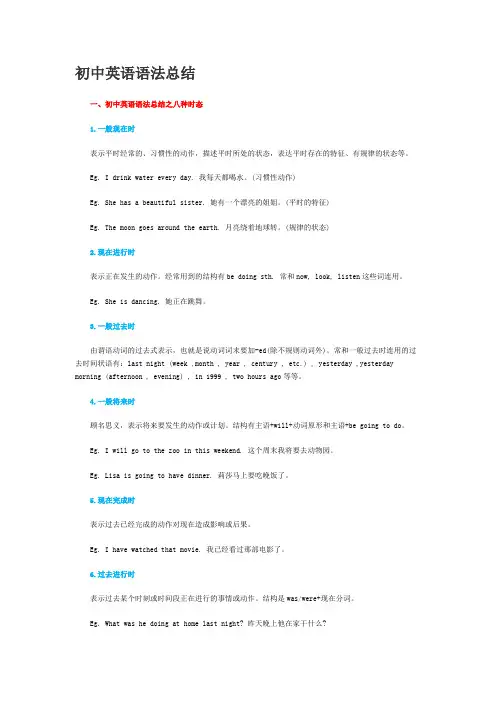
初中英语语法总结一、初中英语语法总结之八种时态1.一般现在时表示平时经常的、习惯性的动作,描述平时所处的状态,表达平时存在的特征、有规律的状态等。
Eg. I drink water every day. 我每天都喝水。
(习惯性动作)Eg. She has a beautiful sister. 她有一个漂亮的姐姐。
(平时的特征)Eg. The moon goes around the earth. 月亮绕着地球转。
(规律的状态)2.现在进行时表示正在发生的动作。
经常用到的结构有be doing sth. 常和now, look, listen这些词连用。
Eg. She is dancing. 她正在跳舞。
3.一般过去时由谓语动词的过去式表示,也就是说动词词末要加-ed(除不规则动词外)。
常和一般过去时连用的过去时间状语有:last night (week ,month , year , century , etc.) , yesterday ,yesterday morning (afternoon , evening) , in 1999 , two hours ago等等。
4.一般将来时顾名思义,表示将来要发生的动作或计划。
结构有主语+will+动词原形和主语+be going to do。
Eg. I will go to the zoo in this weekend. 这个周末我将要去动物园。
Eg. Lisa is going to have dinner. 莉莎马上要吃晚饭了。
5.现在完成时表示过去已经完成的动作对现在造成影响或后果。
Eg. I have watched that movie. 我已经看过那部电影了。
6.过去进行时表示过去某个时刻或时间段正在进行的事情或动作。
结构是was/were+现在分词。
Eg. What was he doing at home last night? 昨天晚上他在家干什么?7.过去将来时表示过去的某时以后将要发生的动作。
初中英语语法八大时态总结
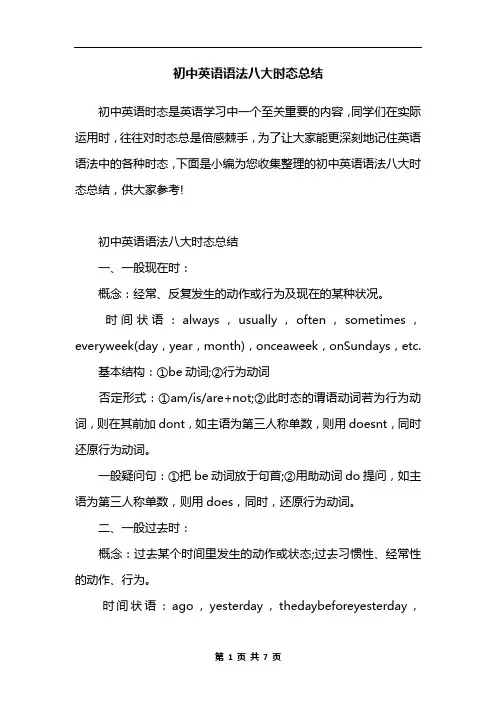
初中英语语法八大时态总结初中英语时态是英语学习中一个至关重要的内容,同学们在实际运用时,往往对时态总是倍感棘手,为了让大家能更深刻地记住英语语法中的各种时态,下面是小编为您收集整理的初中英语语法八大时态总结,供大家参考!初中英语语法八大时态总结一、一般现在时:概念:经常、反复发生的动作或行为及现在的某种状况。
时间状语:always,usually,often,sometimes,everyweek(day,year,month),onceaweek,onSundays,etc.基本结构:①be动词;②行为动词否定形式:①am/is/are+not;②此时态的谓语动词若为行为动词,则在其前加dont,如主语为第三人称单数,则用doesnt,同时还原行为动词。
一般疑问句:①把be动词放于句首;②用助动词do提问,如主语为第三人称单数,则用does,同时,还原行为动词。
二、一般过去时:概念:过去某个时间里发生的动作或状态;过去习惯性、经常性的动作、行为。
时间状语:ago,yesterday,thedaybeforeyesterday,lastweek(year,night,month),in1989,justnow,attheageof5,oneday,longlongago,onceuponatime,etc.基本结构:①be动词;②行为动词否定形式:①was/were+not;②在行为动词前加didnt,同时还原行为动词。
一般疑问句:①was或were放于句首;②用助动词do的过去式did提问,同时还原行为动词。
三、现在进行时:概念:表示现阶段或说话时正在进行的动作及行为。
时间状语:now,atthistime,thesedays,etc.基本结构:am/is/are+doing否定形式:am/is/are+not+doing.一般疑问句:把be动词放于句首。
四、过去进行时:概念:表示过去某段时间或某一时刻正在发生或进行的行为或动作。
初中英语语法时态总结
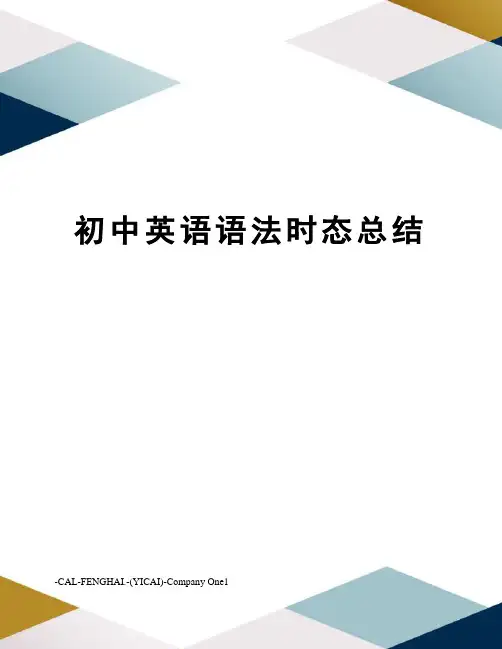
初中英语语法时态总结-CAL-FENGHAI.-(YICAI)-Company One1初中英语语法动词时态总结一、一般现在时1)经常性或习惯性的动作,常与表示频度的时间状语连用。
时间状语:every…, sometimes, at…, on Sunday。
例如:I leave home for school at 7 every morning. 每天早上我七点离开家。
2)客观真理,客观存在,科学事实。
例如:The earth moves around the sun. 地球绕太阳转动。
Shanghai lies in the east of China. 上海位于中国东部。
3)表示格言或警句。
例如:Pride goes before a fall. 骄者必败。
注意:此用法如果出现在宾语从句中,即使主句是过去时,从句谓语也要用一般现在时。
例:Columbus proved that the earth is round. 哥伦布证实了地球是圆的。
4)现在时刻的状态、能力、性格、个性。
例如:I don't want so much. 我不要那么多。
Ann writes good English but does not speak well.安英语写得不错,讲的可不行。
比较:Now I put the sugar in the cup. 把糖放入杯子。
I am doing my homework now. 我正在做功课。
第一句用一般现在时,用于操作演示或指导说明的示范性动作,表示言行的瞬间动作。
第二句中的now是进行时的标志,表示正在进行的动作的客观状况,所以后句用一般现在时。
二、一般过去时1)在确定的过去时间里所发生的动作或存在的状态。
例如:时间状语有:yesterday, last week, an hour ago, the other day, in 1982等。
例如:Where did you go just now? 刚才你上哪儿去了?2)表示在过去一段时间内,经常性或习惯性的动作。
初中所有英语时态
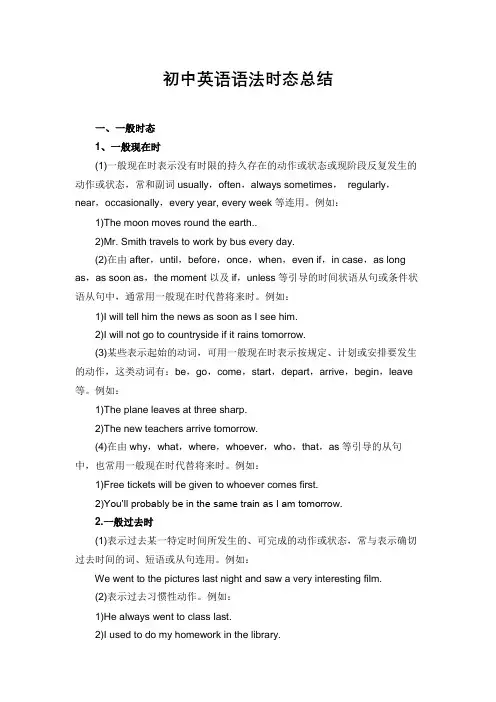
初中英语语法时态总结一、一般时态1、一般现在时(1)一般现在时表示没有时限的持久存在的动作或状态或现阶段反复发生的动作或状态,常和副词usually,often,always sometimes,regularly,near,occasionally,every year, every week等连用。
例如:1)The moon moves round the earth..2)Mr. Smith travels to work by bus every day.(2)在由after,until,before,once,when,even if,in case,as long as,as soon as,the moment以及if,unless等引导的时间状语从句或条件状语从句中,通常用一般现在时代替将来时。
例如:1)I will tell him the news as soon as I see him.2)I will not go to countryside if it rains tomorrow.(3)某些表示起始的动词,可用一般现在时表示按规定、计划或安排要发生的动作,这类动词有:be,go,come,start,depart,arrive,begin,leave 等。
例如:1)The plane leaves at three sharp.2)The new teachers arrive tomorrow.(4)在由why,what,where,whoever,who,that,as等引导的从句中,也常用一般现在时代替将来时。
例如:1)Free tickets will be given to whoever comes first.2)You’ll probably be in the same train as I am tomorrow.2.一般过去时(1)表示过去某一特定时间所发生的、可完成的动作或状态,常与表示确切过去时间的词、短语或从句连用。
初中英语语法八大时态总结
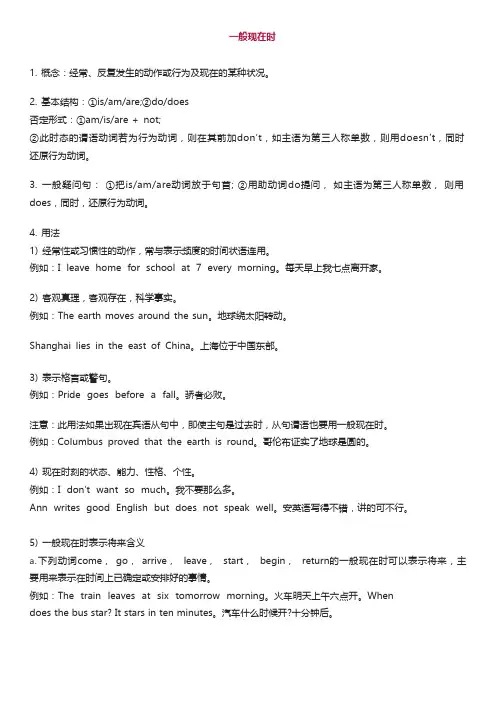
一般现在时1.概念:经常、反复发生的动作或行为及现在的某种状况。
2.基本结构:①is/am/are;②do/does否定形式:①am/is/are + not;②此时态的谓语动词若为行为动词,则在其前加don‘t,如主语为第三人称单数,则用doesn’t,同时还原行为动词。
3.一般疑问句:①把is/am/are动词放于句首; ②用助动词do提问,如主语为第三人称单数,则用does,同时,还原行为动词。
4.用法1)经常性或习惯性的动作,常与表示频度的时间状语连用。
例如:I leave home for school at 7 every morning。
每天早上我七点离开家。
2)客观真理,客观存在,科学事实。
例如:The earth moves around the sun。
地球绕太阳转动。
Shanghai lies in the east of China。
上海位于中国东部。
3)表示格言或警句。
例如:Pride goes before a fall。
骄者必败。
注意:此用法如果出现在宾语从句中,即使主句是过去时,从句谓语也要用一般现在时。
例如:Columbus proved that the earth is round。
哥伦布证实了地球是圆的。
4)现在时刻的状态、能力、性格、个性。
例如:I don‘t want so much。
我不要那么多。
Ann writes good English but does not speak well。
安英语写得不错,讲的可不行。
5)一般现在时表示将来含义a.下列动词come, go, arrive,leave,start,begin,return的一般现在时可以表示将来,主要用来表示在时间上已确定或安排好的事情。
例如:The train leaves at six tomorrow morning。
火车明天上午六点开。
Whendoes the bus star? It stars in ten minutes。
初中英语语法16种英语时态汇总
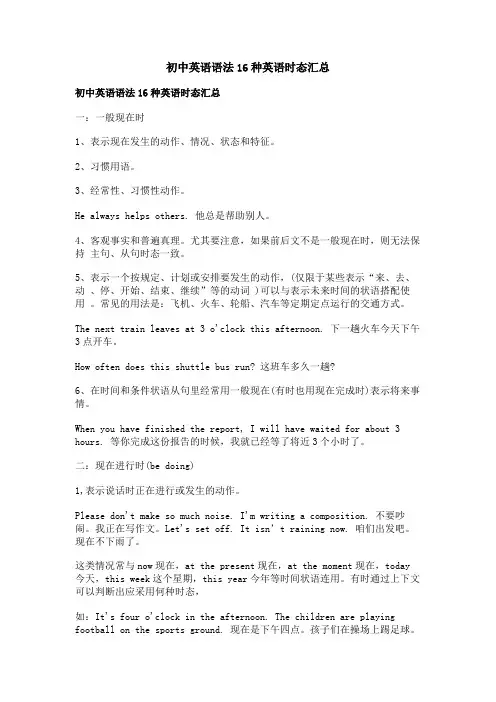
初中英语语法16种英语时态汇总初中英语语法16种英语时态汇总一:一般现在时1、表示现在发生的动作、情况、状态和特征。
2、习惯用语。
3、经常性、习惯性动作。
He always helps others. 他总是帮助别人。
4、客观事实和普遍真理。
尤其要注意,如果前后文不是一般现在时,则无法保持主句、从句时态一致。
5、表示一个按规定、计划或安排要发生的动作,(仅限于某些表示“来、去、动、停、开始、结束、继续”等的动词 )可以与表示未来时间的状语搭配使用。
常见的用法是:飞机、火车、轮船、汽车等定期定点运行的交通方式。
The next train leaves at 3 o'clock this afternoon. 下一趟火车今天下午3点开车。
How often does this shuttle bus run? 这班车多久一趟?6、在时间和条件状语从句里经常用一般现在(有时也用现在完成时)表示将来事情。
When you have finished the report, I will have waited for about 3 hours. 等你完成这份报告的时候,我就已经等了将近3个小时了。
二:现在进行时(be doing)1,表示说话时正在进行或发生的动作。
Please don't make so much noise. I'm writing a composition. 不要吵闹。
我正在写作文。
Let's set off. It isn’t raining now. 咱们出发吧。
现在不下雨了。
这类情况常与now现在,at the present现在,at the moment现在,today 今天,this week这个星期,this year今年等时间状语连用。
有时通过上下文可以判断出应采用何种时态,如:It's four o'clock in the afternoon. The children are playing football on the sports ground. 现在是下午四点。
初中英语语法八大时态总结
初中英语语法八大时态总结一般现在时1. 概念:经常、反复发生的动作或行为及现在的某种状况。
2. 基本结构:①is/am/are;②do/does否定形式:①am/is/are + not;②此时态的谓语动词若为行为动词,则在其前加don‘t,如主语为第三人称单数,则用doesn’t,同时还原行为动词。
3. 一般疑问句:①把is/am/are动词放于句首;②用助动词do提问,如主语为第三人称单数,则用does,同时,还原行为动词。
4. 用法1) 经常性或习惯性的动作,常与表示频度的时间状语连用。
例如:I leave home for school at 7 every morning。
每天早上我七点离开家。
2) 客观真理,客观存在,科学事实。
例如:The earth moves around the sun。
地球绕太阳转动。
Shanghai lies in the east of China。
上海位于中国东部。
3) 表示格言或警句。
例如:Pride goes before a fall。
骄者必败。
Don't give up and don't give in!不要放弃,不要言败!注意:此用法如果出现在宾语从句中,即使主句是过去时,从句谓语也要用一般现在时。
例如:Columbus proved that the earth is round。
哥伦布证实了地球是圆的。
4) 现在时刻的状态、能力、性格、个性。
例如:I don‘t want so much。
我不要那么多。
Ann writes good English but does not speak well。
安英语写得不错,讲的可不行。
5) 一般现在时表示将来含义a.下列动词come,go,arrive,leave,start,begin,return的一般现在时可以表示将来,主要用来表示在时间上已确定或安排好的事情。
例如:The train leaves at six tomorrow morning。
初中英语语法八大时态总结
初中英语语法八大时态总结学校英语语法八大时态总结学校英语时态是英语学习中一个至关重要的内容,同学们在实际运用时,往往对时态总是倍感麻烦,为了让大家能更深刻地记住英语语法中的各种时态,下面是我为您收集整理的学校英语语法八大时态总结,供大家参考!学校英语语法八大时态总结一、一般现在时:概念:常常、反复发生的动作或行为及现在的某种状况。
时间状语:always,usually,often,sometimes,everyweek(day,year,month),onceaweek,onSundays,etc.基本结构:①be动词;②行为动词否定形式:①am/is/are+not;②此时态的谓语动词若为行为动词,则在其前加dont,如主语为第三人称单数,则用doesnt,同时还原行为动词。
一般疑问句:①把be动词放于句首;②用助动词do提问,如主语为第三人称单数,则用does,同时,还原行为动词。
二、一般过去时:概念:过去某个时间里发生的动作或状态;过去习惯性、常常性的动作、行为。
时间状语:ago,yesterday,thedaybeforeyesterday,lastweek(year,night,month),in1989,justnow,attheageof5,oneday,longlongago,onceuponatime,etc.基本结构:①be动词;②行为动词否定形式:①was/were+not;②在行为动词前加didnt,同时还原行为动词。
一般疑问句:①was或were放于句首;②用助动词do的过去式did提问,同时还原行为动词。
三、现在进行时:概念:表示现阶段或说话时正在进行的动作及行为。
时间状语:now,atthistime,thesedays,etc.基本结构:am/is/are+doing否定形式:am/is/are+not+doing.一般疑问句:把be动词放于句首。
四、过去进行时:概念:表示过去某段时间或某一时刻正在发生或进行的行为或动作。
初中英语语法时态总结归纳
初中英语语法时态总结归纳英语语法中的时态是指动词在时间上的形式和表达。
在初中英语学习中,时态是一个非常重要的语法知识点。
掌握时态的正确用法对于学习英语语法和提高英语表达能力非常关键。
本文将对初中英语中常见的时态进行总结和归纳,包括一般现在时、一般过去时、一般将来时、现在进行时、过去进行时等。
下面将逐个进行详细介绍。
一、一般现在时一般现在时表示经常性的、习惯性的动作和现在的真理、主张、感觉等。
在一般现在时中,主语是第三人称单数时,动词要加上-s或者-es。
1. 肯定句的结构:主语 + 动词原形(+ -s/-es)例如:- I play basketball.- He reads books every day.2. 否定句的结构:主语 + do not/ does not + 动词原形例如:- I do not play basketball.- He does not read books every day.3. 疑问句的结构:Do/ Does + 主语 + 动词原形?例如:- Do you play basketball?- Does he read books every day?二、一般过去时一般过去时表示在过去某个时间里发生的动作或存在的状态。
在一般过去时中,动词过去式表示过去的时间。
1. 肯定句的结构:主语 + 动词过去式例如:- I played basketball yesterday.- She watched a movie last night.2. 否定句的结构:主语 + did not + 动词原形例如:- I did not play basketball yesterday.- She did not watch a movie last night.3. 疑问句的结构:Did + 主语 + 动词原形?例如:- Did you play basketball yesterday?- Did she watch a movie last night?三、一般将来时一般将来时表示将来某个时间要发生的动作或存在的状态。
初中英语语法八大时态总结
初中英语语法八大时态总结一般现在时1.概念:经常、反复发生的动作或行为及现在的某种状况。
2.基本结构:肯定形式:①is/am/are; ②do/does否定形式:①am/is/are + not; ②此时态的谓语动词若为行为动词,则在其前加don‘t,如主语为第三人称单数,则用doesn’t,同时还原行为动词。
3. 一般疑问句:①把is/am/are动词放于句首;②用助动词do提问,如主语为第三人称单数,则用does,同时,还原行为动词。
3.用法(1)经常性或习惯性的动作,常与表示频度的时间状语连用。
例如:I leave home for school at 7 every morning。
每天早上我七点离开家。
(2)客观真理,客观存在,科学事实。
例如:The earth moves around the sun。
地球绕太阳转动。
Shanghai lies in the east of China。
上海位于中国东部。
(3)表示格言或警句。
例如:Pride goes before a fall。
骄者必败。
★注意:此用法如果出现在宾语从句中,即使主句是过去时,从句谓语也要用一般现在时。
例如:Columbus proved that the earth is round。
哥伦布证实了地球是圆的。
(4)现在时刻的状态、能力、性格、个性。
例如:I don‘t want so much。
我不要那么多。
Ann writes good English but does not speak well。
安英语写得不错,讲的可不行。
(5)一般现在时表示将来含义①.下列动词come,go,arrive,leave,start,begin,return的一般现在时可以表示将来,主要用来表示在时间上已确定或安排好的事情。
例如:The train leaves at six tomorrow morning。
火车明天上午六点开。
- 1、下载文档前请自行甄别文档内容的完整性,平台不提供额外的编辑、内容补充、找答案等附加服务。
- 2、"仅部分预览"的文档,不可在线预览部分如存在完整性等问题,可反馈申请退款(可完整预览的文档不适用该条件!)。
- 3、如文档侵犯您的权益,请联系客服反馈,我们会尽快为您处理(人工客服工作时间:9:00-18:30)。
初中英语语法时态总结初中英语语法共有16种时态,那么同学们是否学习了呢?一、一般时态1、一般现在时(1)一般现在时表示没有时限的持久存在的动作或状态或现阶段反复发生的动作或状态,常和副词usually,often,always sometimes, regularly,near,occasionally,every year, every week等连用。
例如:1)The moon moves round the earth..2)Mr. Smith travels to work by bus every day.(2)在由after,until,before,once,when,even if,in case,as long as,as soon as,the moment以及if,unless等引导的时间状语从句或条件状语从句中,通常用一般现在时代替将来时。
例如:1)I will tell him the news as soon as I see him.2)I will not go to countryside if it rains tomorrow.(3)某些表示起始的动词,可用一般现在时表示按规定、计划或安排要发生的动作,这类动词有:be,go,come,start,depart,arrive,begin,leave等。
例如:1)The plane leaves at three sharp.2)The new teachers arrive tomorrow.(4)在由why,what,where,whoever,who,that,as等引导的从句中,也常用一般现在时代替将来时。
例如:1)Free tickets will be given to whoever comes first.2)You’ll probably be in the same train as I am tomorrow.2.一般过去时(1)表示过去某一特定时间所发生的、可完成的动作或状态,常与表示确切过去时间的词、短语或从句连用。
例如:We went to the pictures last night and saw a very interesting film.(2)表示过去习惯性动作。
例如:1)He always went to class last.2)I used to do my homework in the library.(注意与be used to doing短语的区别)3.一般将来时1)表示将来打算进行或期待发生的动作或状态。
例如:I shall graduate next year.2)几种替代形式:1)be going to +v在口语中广泛使用,表示准备做或将发生的事情。
例如:I’m going to buy a house when we’ve saved enough money.2)be to +v表示计划安排要做的事,具有“必要”的强制性意义。
例如:I am to play tennis this afternoon.3)be about to +v表示即将发生的事情。
例如:He was about to start.4)be due to +v表示预先确定了的事,必定发生的事。
例如:The train is due to depart in ten minutes.5)be on the point/verge of +v – ing强调即将发生的某种事态。
例如:The baby was on the point of crying when her mother finally came home二、进行时态1.现在进行时(1)表示现在正在进行的动作,常与now,right now,at the mother,for the time being,for the present等连用。
例如:Don’t disturb her. She is re ading a newspaper now.(2)表示现阶段经常发生的动作,常与always,continually,forever,constantly等连用。
例如:My father is forever criticizing me.(3)表示根据计划或安排在最近要进行的事情。
具有这种语法功能的动词仅限于过渡性动词。
即表示从一个状态或位置转移到另一个状态或位置上去的动词。
常用的有:go,come,leave,start,arrive,return等。
例如:They are leaving for Hong Kong next month.(4)有些动词不能用进行时,这是一类表示“感觉,感情,存在,从属”等的动词。
如:see,hear,smell,taste,feel,notice,look,appear,(表示感觉的词);hate,love,fear,like,want,wish,prefer,refuse,forgive(表示感情的动词);be,exist,remain,stay,obtain(表示存在状态的动词);have,possess,own,contain,belong,consist of,form(表示占有与从属的动词);understand,know,believe,think,doubt,forget,remember(表示思考理解的动词)。
但是如果它们词义改变,便也可用进行时态。
例如:1)Tom looks pale. What’s wrong with him?(look在此为联系动词,意为“显得,看上去”)2)Tom is looking for his books.(look在此为实义动词,意为“寻找”)2.过去进行时过去进行时表示一个过去的动作发生时或发生后,另一个过去的动作正在进行,或表示过去反复的习惯,常与always,continually,constantly等动词连用。
例如:1)We were discussing the matter when the headmaster entered.2)Whenever I visited him, he was always writing at the desk.3.将来进行时将来进行时主要表示将来某一时刻正在进行的动作,或表示要在将来某一时刻开始,并继续下去的动作。
常用来表示礼貌的询问、请求等。
例如:1)This time next day they will be sitting in the cinema.2)What will you be doing at six tomorrow evening?4.完成进行时(现在、过去、将来)完成进行时是(现在、过去、将来)完成时的强调形式,将放在完成时态部分讲述。
三、完成时态完成时态通常表示已完成或从事的动作。
它可分为:1.现在完成时(1)现在完成时用来表示对目前状况仍有影响的,刚刚完成的`动作(常与yet,already,just连用),或者过去某一时刻发生的,持续到现在的情况(常与for,since连用)。
例如:1)I have just finished my homework.2)Mary has been ill for three days.(2)常与现在完成时连用的时间状语有:since, for, during, over等引导出的短语;副词already, yet, just, ever, now, before, often, lately, recently等;状语词组this week (morning, month, year), so far, up to now, many times, up to the present等。
例如:1)I haven’t been there for five years.2)So far, she hasn’t enjoyed the summer vacation.3)There have been a lot of changes since 1978.(3)完成时态可用在下列结构中:This (That, It) is (was) the first (second…) time +定语从句;This (That, It) is (was) the only (last) + n +定语从句;This (That, It) is (was) +形容词最高级+ n +定语从句。
如果主句的谓语动词是一般现在时,从句的谓语动词通常用现在完成时;如果主句谓语动词是一般过去时,从句谓语动词通常用过去完成时。
例如:(1)This is one of the rarest questions that have ever been raised at such a meeting.(2)There was a knock at the door. It was the second time someone had interrupted me that evening.2.过去完成时(1)表示过去某时间前已经发生的动作或情况,这个过去的时间可以用by,before等介词短语或一个时间状语从句来表示;或者表示一个动作在另一个过去动作之前已经完成。
例如:1)We had just had our breakfast when Tom came in.2)By the end of last year they had turned out 5, 000 bicycles.(2)动词expect, hope, mean, intend, plan, suppose, wish, want,desire等用过去完成时,表示过去的希望、预期、意图或愿望等没有实现。
例如:I had meant to ta ke a good holiday this year, but I wasn’t able to get away.另外两种表示“过去想做而未做的事”的表达方式是:1)was / were + to have done sth,例如:We were to have come yesterday, but we couldn’t.2)intended (expected, hope, meant, planned, supposed, wished, wanted, desired) + to have done sth,例如:I meant to have told you about it, but I forgot to do so.(3)过去完成时常用于以下固定句型:1)hardly, scarcely, barely + 过去完成时+ when + 过去时。
